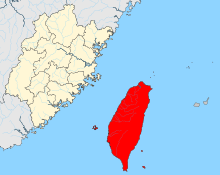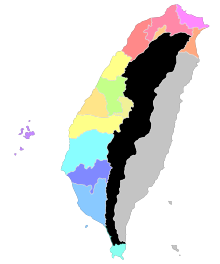Taiwan Prefecture

| Taiwan Prefecture | |||||||||||||||||||
|---|---|---|---|---|---|---|---|---|---|---|---|---|---|---|---|---|---|---|---|
| Traditional Chinese | 臺灣府 | ||||||||||||||||||
| Simplified Chinese | 台湾府 | ||||||||||||||||||
| |||||||||||||||||||
Taiwan Prefecture or Taiwanfu was a prefecture of Taiwan during the Qing dynasty.[1] The prefecture was established by the Qing government in 1684,[2] after the island came under Qing dynasty rule in 1683 following its conquest of the Kingdom of Tungning. The Taiwan Prefecture Gazetteer (臺灣府志; Táiwānfǔ Zhì)[3] documented it as part of Fujian Province.[4] The Gazetteer was completed by Gao Gonggan in 1695, the 34th year of the reign of the Kangxi Emperor.[5] With the development and population growth of Taiwan during the Qing Era, the scope of Taiwan Prefecture was also varied over time. Following the establishment of Fujian-Taiwan Province in 1887, the prefecture correspondingly became a subdivision under the newly founded province.
1684–1723

When the Qing wrested the island from the control of the Kingdom of Tungning in 1683, Taiwan was made a prefecture under the administration of Fujian Province. The new prefecture consisted of three counties:[6]
- Zhuluo County, the central western plains and the north
- Taiwan County, around the prefectural seat at Taiwan (now Tainan)
- Fengshan County, which took up much of present-day Kaohsiung and Pingtung County
The aboriginal lands on the east coast—known to the Qing as the "Land Behind the Mountains" (後山)[7]—were not controlled at all. The seat of government, also known as "Taiwan" or "Taiwanfu" (a contraction of 臺灣府城; Táiwān fǔchéng, "prefectural city of Taiwan"), was located in modern-day Tainan, "which city had been in turn the capital of the Dutch, Koxinga, and the Chinese".[8]
1723–1875


During this period, Taiwan was administered as three counties and two subprefectures.
The counties (縣, xiàn) were, from south to north:[10]
- Fengshan County: one town, 8 Chinese villages, 73 uncivilized native villages, 8 civilized native villages
- Kagi County: one town, 4 Chinese villages, 22 uncivilized native villages, 8 civilized native villages
- Changhwa County: one town, 16 villages
The subprefectures (廳, tīng) were:
- Pescadores Subprefecture
- Tamsui Subprefecture: one town, 132 farms, 70 native villages
1875–1887
An administrative change occurred in 1875, when Imperial Commissioner Shen Baozhen demanded that another prefecture be added in Taiwan to revamp the administrative organization of the northern area of the island.[11] As a result, Taipeh Prefecture was created from part of Taiwan Prefecture.
1887–1895

Fokien-Taiwan Province was established in 1887, consisting of four prefectures: Taipeh, Taiwan, Tainan, and Taitung.[8][13] Tainan Prefecture was created from part of Taiwan Prefecture.[14][15] Thus Taiwan Prefecture was reduced to the area of central Taiwan only, composed of the modern-day Miaoli County, Taichung City, Nantou County, Changhua County, and Yunlin County.
The new prefecture was divided into four counties and one subprefecture: Taiwan County, Changhua County, Yunlin County, Miaoli County, and Puli Subprefecture.[8] The new prefecture seat was located at the central city of Toatun (大墩), which was also designated as the site of the new provincial capital, taking its name as Taiwanfu or Taiwan (now Taichung). However, during construction of the new capital, the provincial capital was temporarily relocated to the city of Taipeh (Taipei).[16] One of the administrators of Taiwan Prefecture was Raymund Tu, a native priest of Taiwan.[17]
Four years after development of Toatun began, the seat of Taipeh (Taipei) was officially declared the provincial capital.[18]
In 1895, with the Treaty of Shimonoseki and the successful Japanese invasion of Taiwan, Taiwan Prefecture was abolished. Under Japanese rule, the province was abolished in favor of Japanese-style divisions.
See also
References
Citations
- ^ Henckaerts, Jean-Marie (12 September 1996). The international status of Taiwan in the new world order: legal and political considerations. Martinus Nijhoff Publishers. p. 268. ISBN 978-90-411-0929-3.
- ^ China: five thousand years of history and civilization. City University of HK Press. 30 April 2007. p. 108. ISBN 978-962-937-140-1.
- ^ "Prefecture History". Taiwanpedia. Archived from the original on 15 July 2014. Retrieved 19 January 2012.
- ^ Teng, Emma (1 March 2006). Taiwan's imagined geography: Chinese colonial travel writing and pictures, 1683-1895. Harvard Univ Asia Center. p. 57. ISBN 978-0-674-02119-8.
- ^ "Chinese Studies in History". Chinese Studies in History and Philosophy. 42 (?). International Arts and Sciences Press: 14. 2008. ISSN 0009-4633. OCLC 560417594.
- ^ Davidson (1903), p. 64:"Taiwan was divided into three "hien" or districts, known as Choolo, Taiwan, and Fangshan, under civil magistrates, and one ''ting" or maritime division, Panghoo (Pescadores) under a marine magistrate. These magistrates submitted themselves to the Taiwanfu or prefect, who in turn was under the authority of the censor of Taiwan, afterwards known as the Taotai, who was the highest authority in Taiwan, and was to make a circuit of the departments once annually."
- ^ 一六八四年滿清據台後,改為一府三縣 [The capital and three counties of Taiwan in 1684, after the Qing seized Taiwan] (in Chinese). Taiwanus.net Inc. 2003.
- ^ a b c Davidson (1903), p. 244.
- ^ "清代臺灣行政區劃沿革". Archived from the original on 2022-08-10. Retrieved 2022-09-27.
- ^ Davidson (1903), p. 93.
- ^ Skinner, George W.; Baker, Hugh D. R., eds. (1977). The City in Late Imperial China. Stanford University Press. p. 197. ISBN 978-0-8047-0892-0.
- ^ "清代臺灣行政區劃沿革". Archived from the original on 2018-10-07. Retrieved 2022-09-27.
- ^ Campbell, William (1915). Sketches from Formosa. London: Marshall Brothers. pp. 278–9. OL 7051071M.
- ^ Gordon, Leonard H. D. (2007). Confrontation over Taiwan: nineteenth-century China and the powers. Lexington Books. ISBN 978-0-7391-1868-9.
- ^ The Chinese times. 1890. Retrieved 19 January 2012.
- ^ Davidson (1903), p. 245: "...the seat of government (which had been formerly at the old town of Taiwan-fu in the south, which city had been in turn the capital of the Dutch, Koxinga, and the Chinese,) was now removed temporarily to the new city of Taipeh, which had been lately in course of construction...In connection with this, it is necessary to go further and explain that it was the intention of the government to build a new capital city in the centre of the island near Changwha. Accordingly, the new city was laid out and the construction of official yamens commenced. The name of the new city became Taiwan-fu, or the capital city of Taiwan (Formosa), and it was also to be the seat of a new prefecture called Taiwan."
- ^ David, M. D. (1985). Asia and Christianity. Himalaya Pub. House. p. 33. OCLC 557532654.
- ^ "From Aboriginal Homeland to Modern City: A Look at Taichung's Rich History". Taichung City Government. 2011-12-27. Retrieved 2014-11-30.
Bibliography
